This Post May Contain Affiliate Links
In compliance with the FTC guidelines, please assume that some of the links on these posts and sites are affiliate links (Amazon or others) from which I may earn a small compensation/commission from sales of certain items at no extra cost to you from qualifying purchases.
Anytime you see a link that looks like “astore.com, paid link, #ad, #CommissionsEarned or Amazon/Amazon.com/ca,”… it can be assumed that it is an affiliate link.
To learn more, follow the link below.
A Buzz Feiten Tuning System Review
Achieving Superior Tuning Stability & Enhanced Intonation
The Buzz Feiten Tuning System, or BFTS, represents a significant advancement in the quest for perfect guitar intonation and tuning stability.
This innovative System addresses common tuning discrepancies in traditional guitar setups and improves intonation accuracy and consistency across the fretboard.
One of the key strengths of the BFTS lies in its comprehensive approach to intonation optimization.
The System tackles the underlying factors that contribute to the Western tuning issues.
Moreover, the BFTS offers versatility and compatibility with various types of guitars, making it accessible to musicians across different genres/styles and players.
Read on as we learn more about this in the Buzz Feiten Tuning System Review.
Guitars Are Out of Tune “By Design”

When playing chord shapes in the different parts of the fretboard, is your guitar sometimes sounding ‘Off” or “Not Right” even though you are re-tuning constantly?
The conventional guitar is an imprecise instrument on many fronts, from Mechanical/Overtone Noise to being slightly out of tune “by design.”
These inherent intonation issues are not found on other, more traditional string instruments, resulting in the guitar maintaining an estimated 80% in-tune success rate.
The reason for this issue of tuning can be…
- Flawed fretboard designs
- Improper Truss rod adjustments
- String gauges without proper setup
- Traditional Tempered Tuning
What Is Equal Tempered Tuning?
Traditional Equal temperament was developed in the late 1500s by classical composers and piano tuners and is still used in Western music and guitars.

In this tuning, the concept is that an octave is divided into 12 semitones, or half-steps, with each division being “Equal” such that intervals in all scales and keys sound the same.
The frets are placed at equal temperament so we can play the instrument in any key and represent a semitone.
That’s good for manufacturing the instrument because it unifies the whole process but does not work for the musicality, for it results in off-sounding or impure musical intervals.
- I.e., a major 3rd interval of a chord in equal-tempered tuning sounds “off,” but the chord sounds as it should if you drop the tunings to accommodate the chord’s intended intervals.
The essence of the traditional equal temperament problem on guitar is that even with intonation adjusted as perfectly as possible, you will never get a guitar fully in tune all the way up the neck.
What Is Intonation On A Guitar?
- Proper Intonation on a guitar is when all the open strings and every note on the fretboard sound at their correct pitches.
- Intonation is off when a guitar is out of tune with itself -meaning it still sounds noticeably “off” even after you’ve tuned the open strings.
Limitations To Equal Temperament Tuning
There are limitations of traditional equal temperament that cannot be entirely eliminated by any adjustments, tricks, or widgets, for every action has an equal opposing reaction.
- I.e., to help meet one requirement for a slightly altered bridge adjustment simultaneously slightly compromises the pure intervals.
But bad Intonation can be improved, and new systems like the Patented BFTS promise to move your guitar from 80% to 95% in tune. (Nothing is perfect.)
Buzz Feiten
Howard “Buzz” Feiten II (born November 4, 1948) is an American singer-songwriter, guitarist, session player, manufacturer and guitar technician/luthier, and is best known for having patented the BFTS tuning system for guitars in the 1990s.
He has played with Gregg Allman, Stevie Wonder, Kenny Loggins and more.
Inspiration
The inspiration to design this Tuning System came from frustration with Feiten struggling with his own guitar tuning and Intonation, which he could never get “right,” affecting his sound quality and playability.
The BFTS Guitar Intonation System

Company Logo image courtesy of buzzfeiten.com
This design’s fundamental purpose/principle is to improve the standard guitars’ inherent intonation/tuning stability over the fretboard.
The System results in little to no out-of-tune chord intervals or discrepancies between fretted and open-string notes.
It creates a more accurate tonality of notes played on the lowest three or four frets by compensating for the differences in string tension and scale length across the fretboard with a 2 tier component of specialized guitar nut and adjustment of bridge saddles.
(Read on)
Instrument Tuning Technology That Incorporates 2 Key Components
- An applied machined high-quality bone, Compensated String or Shelf Nut
- A Custom Tempered Tuning Offset Formula method applied to specific frets using the existing Saddle Adjustments
Shelf Nut Compensation
The original nut is removed and replaced by a modified, non-invasive BFTS “Shelf” Nut.
How close the shelf nut is placed to the first fret is based on precise calculations that combine the guitar’s string gauge, scale length, and fret width. (See Image)
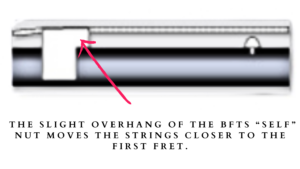
Self Nut Side Image courtesy of buzzfeiten.com
The nut slots are filed to precise measurements to ensure proper string spacing and reduce sharpness at the first 3 frets caused by “End tension.”
“End Tension” is a phenomenon that causes strings to play sharper in pitch near the point of attachment to the nut, typically the first 3 frets.
This is because guitar strings exhibit greater tension at the point of attachment to the nut than they do further up the fingerboard.
Adding the shelf nut slightly changes the scale length to precisely the amount needed to eliminate sharp notes for your particular guitar.
Non-Invasive
Your Authorized Retrofitter will grind the front of the Nut so that the ‘Shelf’ protrudes over the top of the fingerboard.
The slight overhang of the ‘Shelf‘ nut over the fingerboard does not need any fingerboard alterations in any way to be repositioned.
The entire process is non-invasive to your instrument, making it perfectly acceptable for any guitar, including vintage instruments.
This effect is then integrated into the formulas for the tempering process.
Custom Tuning And Saddle Adjustments
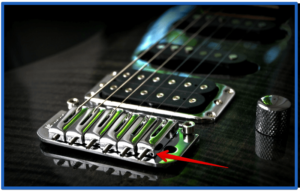
BFTS uses the existing adjustable bridge saddles to help set up the guitar to the System’s standard.
As mentioned, the guitar is intonated according to the BFTS patented pitch offset formulas.
It uses the existing adjustable bridge saddles and, based on the same precise calculations as the nut, the custom tuning system brings each string into pleasing Intonation.
Addressing these 2 factors results in improved chord clarity, smoother fretboard navigation, and enhanced harmonics, with Feiten saying…
“It balances intonation over the entire fingerboard – on every fret – on every string.”
Washburn And The Buzz Feiten Tuning System
The System was licensed to Washburn Guitars (1995–2010) and Suhr Guitars.
These two brands were some of the only major guitar manufacturers to incorporate the System as a standard feature on USA-made production guitars and basses, along with select imported models.
A Godsend To Guitarists
The System has gained popularity among professional guitarists for its ability to enhance the overall playing experience and sound quality.
Players like Nuno Bettencourt, Glenn Frey, Tommy Shaw and Andy Summers were early adopters.
Buzz Feiten Guitars
In 2012, Feiten announced the founding of Buzz Feiten Guitars to manufacture and market solid-body electrics.
The firm initially offered five models: the Blues Pro, T Pro, Signature Elite, Classic Pro, and Elite Pro.
In 2018, the company was renamed Buzz Feiten Guitar Research and began offering three solid-body models with the brand name ‘SuperNova‘: the ‘Classic’ (Two Humbucker pickups), the ‘Futura‘ (Bridge Humbucker and Neck Single-Coil Pickup), and the ‘Futura Super-Trem‘ (Three Single-coil Pickups with Synchronized Vibrato).
Common Advantages & Disadvantages Associated With The BFTS
Advantages
Tuning /Intonation Stability – Optimizing string tension and length, the BFTS helps guitars stay in tune for extended periods, even under challenging playing conditions and delivers consistent tuning and Intonation.
The System Reduces “Sour” Chords – Caused by fretted notes being slightly out of tune, resulting in clearer and more harmonious voicings.
Versatile – The BFTS can be applied to various guitars, including acoustic and bass, making it accessible to many musicians.
Non-invasive – The only visual difference will be a slight overhang of the BFTS Shelf Nut. This is nearly invisible and does not affect fingering at the first fret.
Disadvantages
Installed Only By An Authorized BFTS Retrofitter – Because of the patented bridge offsets and nut replacement, unless the System is pre-installed, the only way to get this is through an authorized BFTS retrofitted.
Implementing the System on guitar requires precision and expertise, often necessitating professional installation by a trained technician or luthier with specific training.
Learning To Compensate – To allow for your instrument’s imperfect intonation, you have likely learned to work around areas of the guitar where intonation issues abound and shape your playing to your guitar’s compromised “design.”
Guitarists accustomed to traditional tuning systems may require some time to adjust to the nuances of the BFTS, particularly regarding fretboard navigation chord fingerings and muscle memory, and an element of relearning may occur.
Still, it will not change how you play.
Costs – The initial investment for installing the BFTS, including specialized hardware and adjustments, may be higher than standard guitar setups.
Some guitar models may require extensive modifications or may not be compatible with the BFTS, limiting its accessibility to specific instruments. Not to mention, if you do not have an authorized tech in your facility, it could mean shipping off your instrument to another city or location, adding to the costs.
Maintenance – While the BFTS improves tuning stability, regular maintenance and adjustments may still be necessary to ensure optimal performance over time.
FAQ
Who Is The BFTS For?
The BFTS is primarily designed for guitarists of all levels, including professional musicians and hobbyists, who seek improved tuning stability and intonation accuracy for their guitars.
It is especially beneficial for those who perform extensively or record music, as it helps to minimize tuning issues and ensure consistent sound quality across various playing environments.
Additionally, the BFTS can be advantageous for guitar technicians and luthiers who work on guitar setups and maintenance, as it provides a systematic approach to addressing tuning discrepancies and optimizing the performance of instruments.
Overall, the Buzz Feiten Tuning System caters to anyone who values precision and reliability in their guitar tuning, regardless of their skill level or musical genre.
How Can I Tell If The BFTS Is Installed On A Guitar
Check the back of the headstock for the BFTS Logo Sticker on guitars that have the System included by the manufacturer. (See Image)
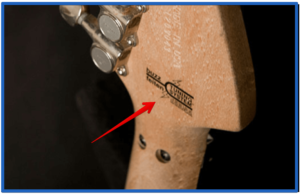
Washburn USA Custom Shop (N4AUTHENTIC-D) Headstock with BFTS Logo Sticker – Image courtesy of Amazon
If the BFTS Serial Numbered Logo Sticker is not on the headstock or any part of the guitar, there is no way to prove that one of the companies’ authorized reps did adequately install the System.
Simply…If it doesn’t have the sticker, it doesn’t have the BFTS.
Can The Tuning System Be Installed On Other Stringed Instruments?
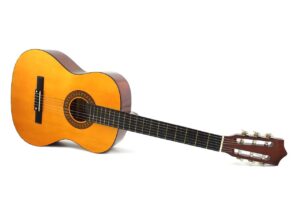
Yes!
In addition to electric guitars and basses, any fretted stringed instrument can be retrofitted. (i.e. mandolins, banjos etc.)
Added Modifications To Acoustics
Acoustic guitars have a fixed saddle and bridge that can not be individually adjusted, so these designs require additional modifications.
Some acoustic guitars, like the typical classical nylon string, are more problematic to retrofit regarding intonation and tuning inconsistencies.
However, they are some of the most dynamic examples of how well the System works once retrofitted.
Can The BFTS Be Compatible With Floating Bridges & Locking Nuts?
Yes.
Tremolo systems and locking nuts perform like stock nuts and saddles when retrofitted to the BFTS specifications.
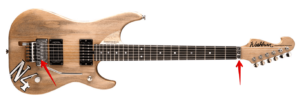
Washburn USA Custom Shop 6 String Solid Body Electric Guitar (N4AUTHENTIC-D) w/Floyd Rose locking, EVH D-tuna & BFTS – Image courtesy of Amazon
Can This System Be Installed With A Zero-fret?
Yes.
In these cases, the zero fret is positioned the same as the BFTS Shelf Nut, producing the same effect and in accordance with the system specifications for a particular guitar.
How Does This System Work With Alternate Tunings?
If the guitar is normally played in standard tuning and occasionally tuned to alternate tunings, up to a whole step down (i.e. Drop D) on the lower strings, your BFTS retrofitted guitar will retain pleasing Intonation.
If you drop your guitar down a whole step for all strings, you may need minor setup adjustments (truss rod, etc.) to compensate for the different string tensions.
If you have questions, check with your Authorized BFTS Retrofitter.
Video
Here is Buzz Feiten explaining why and how the System was developed. He also demonstrates the incredible results.
Quotes From The Industry
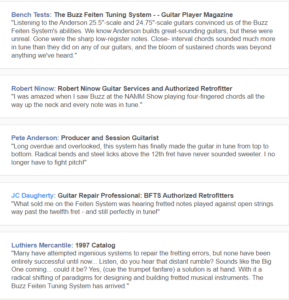
Final Thoughts

The science behind the method seems sound to me.
Some guitarists claimed to hear no difference, perhaps attributed to their particular playing style, guitar or musical genre.
Others believe that the System marked improved accuracy virtually everywhere on the fretboard.
Also, even though some compensation may be needed in your playing after you get used to the new setup, the focus can be on your technique and expression rather than being distracted by the tuning inconsistencies.
While the initial setup and installation of the BFTS may require some time and resources, I think anything that improves the inherited Intonation on your guitar far outweighs any challenges.
The other factor is that maintenance for future setups can only be set correctly by someone with the proper tuning equipment and knowledge of the “patented” offsets, which might be an issue in some locations.
That’s my challenge.
My Washburn has not been appropriately maintained simply because we do not have a local BFTS tech.
Did You Like This Article?
Check out our post on Multi-Scale Guitars
Also…
Leave your comments below if you want me to review a favourite Guitar or accessory.
As always, stay the course and keep playing.
Feature image courtesy of Greg Fordyce from Pixabay
Image for Guitar saddles and bridge courtesy of PIRO from Pixabay
Image of Classical Nylon string acoustic courtesy of PublicDomainPictures from Pixabay
All AI-generated images courtesy of Co-pilot

Starting A Journey At 7 Years Of Age, The Love For The Guitar Only Became Stronger Going Into My Teens. This Leading To An Exciting Time Of Teaching, Performing, And Recording. Join Me Now As We Can Bring The Love Of This Instrument To Other Musicians Globally.


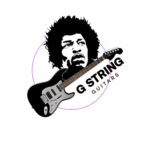





I found your review of the Buzz Feiten Tuning System quite informative! It’s intriguing how it claims to enhance tuning stability and intonation accuracy. Have you personally noticed a significant difference in the performance of guitars equipped with this system compared to those without it? As a guitarist, I’m always on the lookout for tools and systems that can improve the overall playability of my instruments.
Your detailed explanation of how the system works and its potential benefits is helpful for anyone considering investing in it. However, I’m curious about any potential drawbacks or challenges you encountered while using the Buzz Feiten Tuning System. Every product has its pros and cons, and it would be interesting to hear a balanced perspective. Thank you for sharing your insights and helping guitarists make informed decisions about their gear!
Hello Pasindu
Thank you for coming by the site and leaving your thoughts
To answer your questions.
With my Washburn, because I cannot find a BFTS tech in our area, my guitar has been a challenge to get up to standard, but that being said, it’s still one of my best-sounding stage axes.
That is one of the only drawbacks, which is setting it up by a BFTS, outside of the pros and cons mentioned in the post.
I feel that anything that will help improve the guitar’s design flaws is good.
But I am not convinced it is needed on all guitars. They are all different, and you will have to see if yours will benefit. For example, if you have a multiscale with fan frets, your guitar may not be able to work with this system, but that is a luthier’s question.
I hope that helps.
Please feel free to comment on some of the other posts and share your thoughts.
Dino@gstringuitars